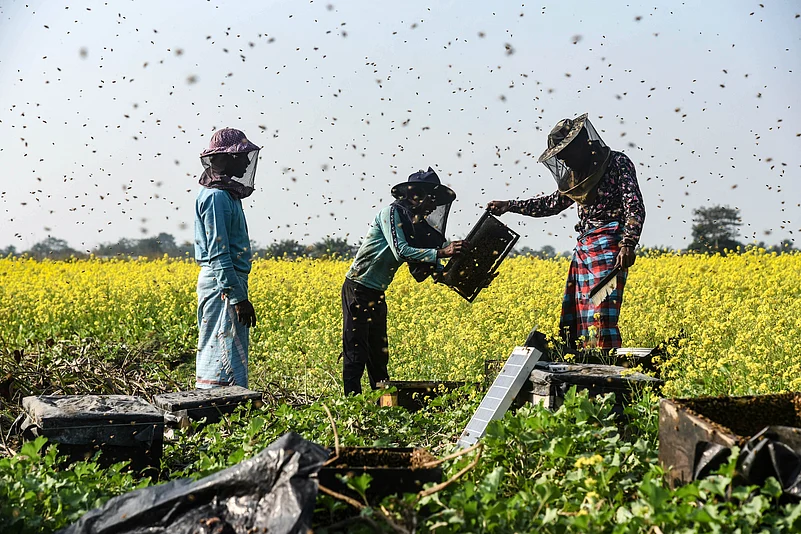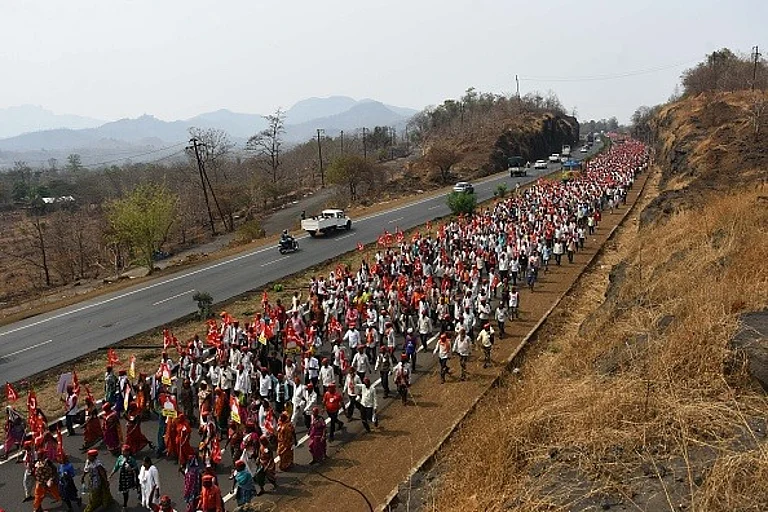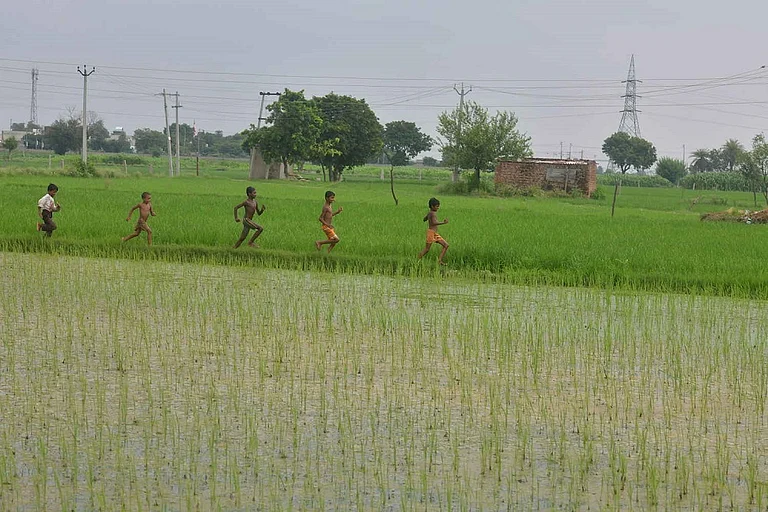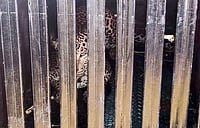
Honeybees are migrating from rural farms into cities, causing losses on farms.
Maharashtra is launching a Bee Friends initiative this September.
Farmers are seeing early signs of recovery in bee populations, hope for me.
For fifteen years, Mauli Jadhav has watched the number of honeybees on his organic farm in Beed, Maharashtra, dwindle.
“Despite being an organic farmer, I only have two beehives. This is too little,” he said. “Those of us with large orchards rely completely on honeybees as cross-pollinators for our yield. But now they have left our farmlands,” Jadhav says.
Bees abandoning rural areas for cities is not an isolated observation but a distinct new trend, and it has not gone unnoticed in Maharashtra. Conservationists and the state government have launched a “Bee Revolution” to bring bees back to farms and encourage urban residents to make space for them in city landscapes.
Bee Friends Effort
In response, the Maharashtra government, in partnership with conservationist Amit Godse’s outfit, Bee Basket, is launching Bee-Friends, a statewide effort set to launch from Pune this autumn. The aim is to train urban volunteers in rescuing and protecting honeybees through sustainable beekeeping. Eventually, the bees will be relocated to farms where their pollination services are needed.
“We intend to start a beehive free movement in Maharashtra,” said Ravindra Sathe, Chairman of the Maharashtra State Khadi and Village industries Board (KVIB). “It will begin as a small yojana but will grow into a bee movement.”
The effort began when the Prime Minister’s Office took note of a special mention by Godse in a recent episode of his radio broadcast, Mann ki Baat, but will only begin functioning in September.
Bees are not just another insect. They are among the most efficient pollinators, vital to biodiversity and food security. According to the Food and Agriculture Organisation’s estimates, a third of the world’s food production depends on bees being able to do their job effectively. From orchards to oilseed farms, they pollinate crops from almonds, coffee, cocoa, soybeans, fruits and vegetables, worth billions of rupees, every year.
A study led by researchers Shaden AM Khalifa of Stockholm University underscores that pollination improves yields in quantity as well as quality. The flavours are also richer when bees have had a go at natural pollination. Without honeybees, harvests would shrink and crops become less diverse. Bees do much more than plants can do via self-pollination.
Why Bees Are Leaving Farms
Godse, a techie-turned-bee conservationist from Pune discovered a new pattern in honeybee migration in Maharashtra. He found that they were “abandoning farmlands and forests and migrating to cities”. Godse, had already been working on bee-rescuing in urban Maharashtra. He explained the four essential elements a bee needs to create a hive: the correct height, adequate water all year around—ruling out seasonal forests—and also isolation and ecological diversity.
He said, “Beehives have become rare in forests due to the deforestation in the Western Ghats. The natural forest ecology in Maharashtra comprises short indigenous trees, whereas bees only make hives at heights of 150 to 200 feet. The Forest Department tried changing this by planting exotic species like eucalyptus and acacia trees. However, wild bees only settle on indigenous trees.”
And then pesticide use in agriculture has harmed many bee species, either killing them, reducing the strength and productivity of bee colonies, or subtly hurting populations by impairing the tiny creatures’ cognition and memory. This can disrupt their foraging and pollination behaviour, ultimately driving them into cities.
“Cities have become the new hotspot for bees,” said Godse, where high-rise buildings provide them with the necessary height, and the opportunity to search for perennial water sources and biodiversity “from balcony to balcony”. He says there are now more beehives in cities rather than in farms or forests.
In Pune, the population of honeybees is marginally higher because it has more green cover compared with Mumbai, more high-rise buildings than Mahabaleshwar and its ideal location along the Western Ghats, Godse has found.
Mauli Jadhav, the Beed-based farmer, has also observed hives deplete since 2011, and that has left him feeling alarmed. “The truly important bee is the small stingless one,” he said. Their size allowed them to reach the pollen basket of tiny flowers other insects can’t access. Their hairy bodies could collect plenty of pollen, which once made them the biggest cross-pollinators on the area’s farms, he said.
Unfortunately, not all local farmers understood the value of such bees for their land, Jadhav said. He added, “Some saw bees as a nuciance.”
One of the main crops in Beed is soybean, which is 93 per cent self-pollinated, meaning that it doesn’t need any intervention to ripen. The remaining seven per cent must be cross-pollinated. But if bees keep migrating to cities, that seven per cent will be lost, both in terms of yield and its quality. “Some farmers here don’t understand the impact of even small percentage on overall yields, and thus out,” said Jadhav.
While awareness is growing through visits from agriculture officers and government campaigns, change has been slow. An earlier effort by Agricultural Technology Management Agency (ATMA) to introduce 230 bee boxes in Beed had to be rolled back due to the harsh arid climate condition and continued pesticide use.
Jadhav, however, has seen some success by planting mustard seeds alongside his regular crops. Bees find the mustard flower irresistible and, as a result, Jadhav has noticed two new hives crop up on his land.
“I’m fortunate to have even the few bees I do,” he said, “But that is too little. Farmers need bees to return to farmlands to sustain our livelihoods.”
Rescue to Revival?
Over the past nine years, Godse claims to have saved over 17,000 beehives from cities. Through an initiative titled Pests to Pets, he and his team have relocated hives to farmlands where they are essential.
The KVIB has been running a Honey Mission, too, hoping to create awareness among farmers on the role of honeybees in agriculture. The government helps farmers learn about beekeeping, and provides a 50 per cent subsidy to participants. Farmers who once saw bees as parasites now request conservationists like Godse for help with arranging beehives on their lands.
Sathe of the KVIB says the Maharashtra Chief Minister’s office called him to enquire about the efforts to promote bee relocation. “That is how Godse and the KVIB ended up sharing our knowledge on the condition of bees and, after our talks, we decided to start Bee-Friends across Maharashtra, starting from Pune.” Bee Basket is partner with KVIB in conducting workshops related to bee-keeping.
To Sathe, the primary aim is to begin documentation and data-collection, at the state level, of Maharashtra’s rich flora and fauna. “NGOs and private initiatives are doing their part, providing us with information, but it is time to initiate serious documentation,” Sathe said. He said the scheme has sparked hopes of taking a step towards achieving this.
Farmers like Jadhav are cautiously optimistic. “Bees are returning slowly,” he said, “but the increase in knowledge and efforts by conservationists and the government over the past fifteen years gives me hope.”






























